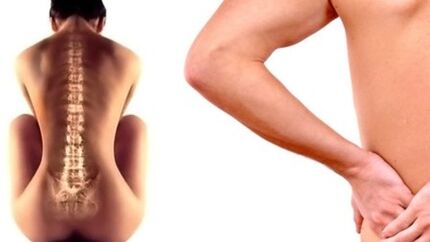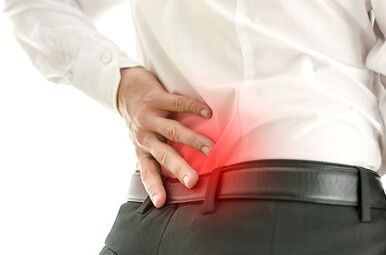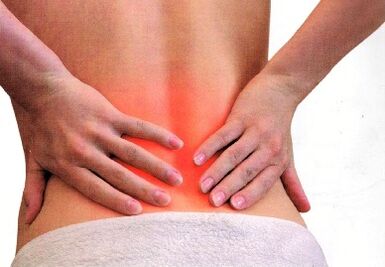Low back pain is one of the most common reasons for a patient to seek help from a neurologist or therapist. Lumbosacral spine pain can go away forever, making it impossible to move and take care of yourself. Acute low back pain affects both men and women equally.
More often than not in middle-aged and older people, back pain can often be observed in adolescents and young adults. This is due to rapid growth, weakness in the fragile muscles of the lower back, injuries. Thus, lumbosacral spine pain is the most pressing problem that anyone can face.

Low back pain with lumbar osteochondrosis
With osteochondrosis, back pain can be aggravated by coughing and sneezing, with any movement, especially when the body is bent forward. In addition to low back pain, osteochondrosis of the spine can manifest itself as a violation of the sensitivity of certain parts of the skin or muscles of the torso and lower half of the legs, weakening or absence of tendon reflexes in the legs.
- As a rule, with osteochondrosis there is a curvature of the lumbar spine. Scoliosis (right or left bending), lordosis (forward bending) and kyphosis (lumbar straightening or even backward curvature) are differentiated according to the plane in which the curve occurs. When the spinal cord is compressed with osteochondrosis, in addition to urinary or fecal disturbances, the sensitivity of the bladder or genitals is impaired.
- However, in most cases, osteochondrosis of the spine manifests itself with radical pain - ie. develops as a result of compression of nerve roots extending from the spinal cord to one degree or another. Thus, one of the well-known lumbar syndromes is lumbago. Physical stress occurs instantly or in an awkward position of the body and sometimes for no apparent reason. Suddenly, within a few minutes or hours, there is a sharp shooting pain ("lumbago"), often burning and exploding ("the lumbar region remained in the lumbar region").
The patient freezes in a restless state, unable to correct an attack while lifting weights. Attempts to get out of bed, cough, or bend one leg are accompanied by a sharp increase in the spine and sacrum. If the patient is asked to stand, acute immobility of the entire lumbar region is detected due to muscle tension.
Lumbosacral osteochondrosis tests
These tests are used as a tool for initial diagnosis, given the names of the doctors who offer them.
| Degree symptom | If you squeeze your abdomen and listen to your back, the pain will intensify. In this case, the patient is more likely to have osteochondrosis. |
| Nerinin symptom | If the head is sharply bent forward before touching the chest, there is pain in the lower back, which indicates problems with the spine. |
| Lasegue symptom | This can be felt after the following movements: lie on your back and lift each leg in turn. After that, if the spine is bent down and the pain is transmitted to the leg along the sciatic nerve, it is evidence of spinal pathology. |
| Larrey symptom | If a person has pain along the sciatic nerve, we are talking about the manifestations of chondrosis after the knees rise forward without bending in a lying position. |
Herniated disc
Herniated disc is an equally rare cause, the clinical manifestation of which is pain in the lumbosacral spine. In addition to long-term traumatic exposure, the intervertebral disc (inner nuclear pulposus) loses its elastic properties and elasticity with age.
With continuous exposure (overweight, trauma, progressive osteoporosis), the disc fibrous fibrosis becomes thinner and defects appear. Through these weak points in the annulus fibrosis, the nuclear pulp of the disc can change and even come out.
Causes of back pain
Back pain is a non-specific symptom that can have a variety of causes. Depending on how intense the back pain is, whether permanent or periodic, primary or secondary, the reasons may be:
Chronic pain:
- Osteomyelitis;
- Ankylosing spondylitis;
- Spondylosis deformities;
- Growth diseases - scoliosis;
- Infectious lesions of the intervertebral discs and vertebrae (epidural abscess, spinal tuberculosis, brucellosis);
- Metabolic bone diseases - osteomalacia, osteoporosis;
- Primary and metastatic tumors of the spinal cord, spinal cord, retroperitoneal cavity;
- Non-infectious inflammatory diseases - rheumatoid arthritis, Reiter's syndrome, ankylosing spondylitis;
- Kidney tumors;
- Atherosclerosis of the abdominal part and branches of the aorta.
Acute pain:
- Spondyloarthritis;
- Pathology of the hip joint;
- Spinal epiduritis;
- Dislocation of the intervertebral discs in the lumbar region;
- Osteochondritis of the spine;
- Acute intervertebral hernia;
- Intestinal obstruction, atypical course of acute appendicitis;
- Urolithiasis;
- Acute sprains, vertebral fractures;
- Lumbago, sciatica;
- Acute disorders of the spinal cord - stroke;
- Acute pyelonephritis.
Radiation pain in some diseases of the internal organs:
- Diseases of the pelvic organs. In women - inflammatory processes in the uterine appendages, endometriosis, uterine cancer, ovarian cancer, STIs (chlamydia, ureaplasmosis, gonorrhea, trichomoniasis, etc. ) In men - prostatitis, prostate cancer;
- Diseases of the stomach, pancreas, duodenum, gallbladder;
- Intestinal diseases - inflammation of the diverticulum, ulcerative colitis, intestinal tumors;
- Kidney disease - renal colic, kidney stones;
- Aortic aneurysm.

Physiological causes
The following back pain may occur:
- You are overweight;
- Additional risk for women;
- Are you pregnant or have recently given birth;
- Spend a lot of time driving a car or computer;
- Maintain a sedentary lifestyle (office workers) or standing people (salespeople, waiters, street signers, surgeons);
- Perform dynamic physical labor with a sharp change in body position (especially if your specialty is related to strenuous physical activity);
- Overload at the gym or fitness club. Be extremely careful if you have recently started training;
- You love summer cottage work;
- You have reached postmenopause, which is favorable for the development of osteoporosis.
Back pain and pregnancy
Pregnancy increases the manifestations of diseases in the mother's body. Pathologies due to changes in hormonal levels and increasing loads manifest themselves, especially in the second half of pregnancy. In addition to the pain associated with the risk of premature birth, back pain in pregnant women can also be caused by:
- herniated disc;
- radiculitis;
- pancreatitis;
- pyelonephritis;
- urolithiasis (kidney stones).
Why does the lower back hurt?
In addition to obvious diseases of the spine (sciatica, lumbago, intervertebral hernia, ankylosing spondylitis, etc. ), possible causes of pain during menstruation in women, diseases of the female genital organs, when the lower back hurts. Inflammation of the uterine tract - oophoritis, salpingo-oophoritis (adnexitis), as well as pelvic peritoneum, intestinal diseases, inflammation of the appendix (appendix of the appendix), in men - diseases of the prostate gland, bladder.
Pain in the upper back
If there is pain on the right side of the upper back - liver pain, with any pathological changes in the liver - hepatitis, liver failure, can be irradiated by taking toxic drugs. In this case, the pain is most often localized in the right hypochondrium.
If the pain is felt in the upper back to the right or left, the cause is acute kidney disease. Many chronic kidney diseases, such as polycystic kidney disease, malignant neoplasms of the kidneys, and chronic pyelonephritis, are accompanied by minor symptoms as the kidney capsule gradually lengthens.
When should you see a doctor?
- If the back pain spreads below the waist and is located a little higher (in the chest area). The pain is accompanied by sweating, vomiting and nausea, shortness of breath.
- The pain spreads to the peritoneum, chest, neck and chin.
- The patient is dizzy and confused.
- Tachycardia begins.
- Accompanied by spinal trauma, defecation, loss of urinary control.
- Legs weaken, hips, genitals fall asleep.

Diagnostics
A thorough diagnostic examination should be performed to determine which disease is causing the back pain.
Laboratory methods:
- General and biochemical analysis of urine and blood.
- Tests for tumor markers present in the blood at the time of tumor formation.
Instrumental research methods:
- Radiography of the spine.
- Endoscopy of the intestines, stomach and uterus.
- Ultrasound examination of the abdominal cavity.
- Magnetic resonance imaging.
How to treat back pain?
How to properly treat the lower back? The approach to back treatment depends entirely on the symptoms of the disease, the diagnosis made by the doctor and the stage of the disease. Generally, an integrated approach covering several treatment methods is used.
Pain medications. . .The ointment helps to eliminate inflammation, stretch, and has a warming effect if the back is cold.
The following groups of ointments differ:
- mixed drugs (used in sprains and injuries, with anti-inflammatory and analgesic effects, have a healing effect due to its ingredients);
- anti-inflammatory analgesics (contain drugs that have a cooling effect that eliminates irritation - menthol, lavender and painkillers);
- chondroprotectors (one of the active components of such drugs is a substance used in pathological processes in cartilage tissue, which helps in the active regeneration of cartilage surfaces of joints);
- irritants (the effect is based on vasodilation and blood flow to the source of pain).
With the help of therapeutic exercises, the patient can reduce pain, strengthen muscles, increase the distance between the vertebrae. It will help release compressed nerve roots, normalize blood flow to the affected area and improve metabolic processes.
In order for such gymnastics to improve, not to be disabled, all the recommendations of the attending physician must be followed.
- The movements are performed slowly and smoothly without sharp turns;
- The room should be ventilated before training;
- The patient should wear clothing that does not restrict movement;
- Exercise is performed while breathing and must return to its original position on exhalation;
- The load is gradually increasing. First, the number of approaches is about 10 and then increases;
- You need to monitor your well-being during gymnastics. If a sharp pain begins, you should stop working.
In addition, massage is excellent for relieving back pain. The positive therapeutic effects of massage include:
- improving the blood supply to the diseased part of the body;
- knead the muscles, it also makes them and ligaments more elastic and resilient;
- elimination of acute pain;
- get rid of toxins accumulated in the muscles and subcutaneous tissue;
- pleasant sensations due to stimulation of the nerve endings of the skin;
- positive emotions.
It can be entrusted to a specialist in the clinic or carried out at home, in any case, the benefits from it will be invaluable.
Which doctor should I see?
For low back pain of unknown cause, the first step is to see a therapist. It will help to diagnose the disease with a combination of symptoms.
If the reason is clear: the pain was previously an injury, the pain occurred against the background of pregnancy, menstruation or a chronic illness, it makes sense to immediately contact a narrower specialist.
Self-medication is allowed only if the exact cause of the pain is known.
















